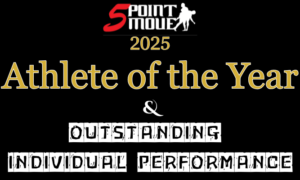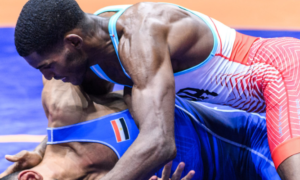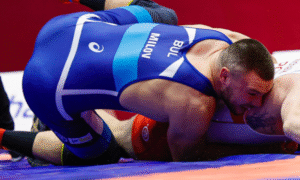Voting is now open for Five Point Move‘s year-end awards — Athlete of the Year, Outstanding Individual Performance, and Impact Performer. Below find the procedural explanations for each award along with their accompanying polls.
Skip to Section
— Athlete of the Year voting
— Impact Performer voting
— Outstanding Individual Performance voting
There are two voting tiers for Athlete of the Year:
— The fan vote is used to determine the top-5 candidates by midnight (ET) on December 29.
— Once the voting deadline has been reached, the 5PM AOTY Voting Committee will then select the winner from the top-5 candidates who emerged from the fan vote.
— The 2024 5PM Athlete of the Year will be named on January 2.
2023 5PM AOTY VOTING COMMITTEE
Joe Betterman — Multi-time US National Team; 2007 World Team member; Colorado USA Wrestling Chairman
Jim Gruenwald — Two-time US Olympian; three-time World Team; two-time Pan Am Championships gold; head coach, Wheaton College
Sam Hazewinkel — 2012 Olympian; ’18 World Team; ’08 University World Champion; multi-time US National Team
Jim Martinez — 1984 Olympic bronze; ’85 World bronze
Max Nowry — 3X US World Team; 4X National Champion; ’12 University World Champion; 4X Pan-Am Championships gold
Paul Tellgren — Former US National Team member; 5PM Contributor
Joe Uccellini — New York State Greco-Roman/freestyle developmental head coach; founder of Curby 3-Style Wrestling
2024 ATHLETE OF THE YEAR VOTING PROCEDURES
The procedures to determine eligibility for Athlete of the Year are different for ’24 compared to most iterations of the award. This is due to several factors. There were not one but two Senior-level selection events held this year (Olympic Trials, April; non-Olympic World Team Trials, September) — and there was not a US Open (or Senior Nationals). However, there were also three athletes who earned U20 World medals as well as one wrestler who made the podium at the U23 Worlds, which was a first for the US program.
It should be noted that athletes who won the Olympic Trials were, according to this platform, members of the US Olympic Team even if said athletes did not eventually appear in the Paris Olympics.
— US Olympic Team
— US World Team
— U20/U23 World medalist
2024 5PM AOTY Candidates
55 kg
Isaiah Cortez (Daniel Cormier WC) — U20 World silver
Brady Koontz (Dubuque RTC) — US World Team
60 kg
Dalton Roberts (Army/WCAP) — US Olympic Team, Valamar Cup silver
63 kg
Otto Black (CTT/Hawkeye WC) — U20 World silver, Haavisto Cup gold, Haparanda Cup silver
Ildar Hafizov (Army/WCAP) — US World Team, CISM Military World silver
67 kg
Ellis Coleman (Army/WCAP) — US Olympic Team
72 kg
Benji Peak (Combat WC) — US World Team, Valamar Cup bronze
77 kg
Kamal Bey (Army/WCAP) — US Olympic Team, World OG Qualifier bronze, CISM Military World bronze
82 kg
Aliaksandr Kikiniou (NYAC) — US World Team, Olympic Trials runner-up
Beka Melelashvili (NYAC) — U23 World silver, Druskininkai Cup silver, Valamar Cup bronze
87 kg
Payton Jacobson (NMU/NTS) — US Olympic Team, Valamar Cup bronze
97 kg
Joe Rau (TMWC) — US Olympic Team, Nikola Petrov Memorial bronze
130 kg
Aden Attao (Beaver Dam RTC) — U20 World bronze
Adam Coon (NYAC/Cliff Keen) — US Olympic Team
AOTY Vote
2024 Impact Performer Voting
The candidate list for Impact Performer in ’24 is the shortest in the history of the honor and this is due to the fact that there are only two qualifying factors:
— An athlete had to have earned gold from at least one international event and placed in a minimum of two.
— Senior events only.
— Voting open now until midnight on December 29.
Although the US did have several Senior competitors come away with gold from international/overseas events this year, only two managed to place in another event. And both did so just under the wire.
Otto Black (63 kg, CTT/Hawkeye WC) and Austin DeSanto (60 kg, TMWC/Hawkeye WC) traveled together towards the end of November in advance of the Haparanda Cup (Sweden). Black finished with silver in that tournament whereas DeSanto had earned bronze. One week later, both wrestlers stood atop the podium at the Haavisto Cup (Finland).
Impact Performer Candidates
Otto Black (63 kg, CTT/Hawkeye WC) — Haavisto Cup gold, Haparanda Cup silver
Austin DeSanto (60 kg, TMWC/Hawkeye WC) — Haavisto Cup gold, Haparanda Cup bronze
2024 Outstanding Individual Performance
Outstanding Individual Performance isolates the efforts of one Greco-Roman athlete at a single tournament or event. Candidates are determined according to subjective but relevant contextual parameters. Like Impact Performer, OIP is decided entirely by fan vote. Voting begins today and runs until midnight on Sunday, December 29.
— Highlighted performance represented a breakthrough or milestone achievement for the athlete or;
— A signature win over a foreign or domestic opponent was included, or;
— Athlete overcame perceived odds or adversity.
— Athlete had to have placed at said event.
— Senior events only.
2024 OIP Candidates
Max Black (60 kg, NMU/NTS) — US Olympic Team Trials (3rd)
Black was one of the most consistent athletes in the entire country throughout ’24 with multiple impressive showings both at-home and abroad. Though one could argue that his advancement to the non-Olympic Trial finals in September was more of a “breakthrough” (as it was the first time Black had done so on the Senior level), his placing 3rd and reaching National Team honors at the Olympic Trials provided the best evidence pertaining to his competitiveness, talent, and perseverance. In a field that was fraught with serious challengers, Black held strong by decisioning always-tough Dylan Gregerson and, following a close loss to eventual Trials champ Dalton Roberts (Army/WCAP), closed out with dazzling victories over the likes of Phillip Moomey (Spartan Combat RTC) and Taylor LaMont. Black has carried a lot of hype with him since arriving at NMU three years ago and all of his on-the-mat brashness keeps getting backed-up by noteworthy performances. That he withstood the tests thrown at him in April and built even more momentum towards the future speaks to his resolve.
Ellis Coleman (67 kg, Army/WCAP) — US Olympic Team Trials (1st)
The circumstances were simple to understand. Coleman, at 32, had only returned in February for the Armed Forces Championships following a ridiculous, wrongful USADA doping sanction that put him on the shelf for two years. Yes, he was still considered viable despite the hiatus, and yes, he was able to get himself overseas for a stint prior to the April Trials and work off some additional rust. But it was a lot to ask. Questions surrounding Coleman’s candidacy were centered more on his ability to endure than they were with regards to his skill-set or sharpness, whatever that might have even meant considering what he was about to attempt. Alas, it always seems to pay when a man of faith insists on being harder than the situation in which he finds himself. One by one — Pete Ogunsanya (Army/WCAP), ’23 US Open winner Robert Perez III (NYAC), ’23 World Teamer Xavier Johnson (Army/WCAP), and, finally, returning Olympian/multi-time World Team member Alex Sancho (Army/WCAP). Coleman got past them all to once again summit the domestic mountaintop. Of all the stories told in ’24, this individual run from the April Trials might be the most inspiring. Coleman said after the tournament that he leaned on God to get him through each round. It is easy to believe him because, given the entire scenario, it is also the best explanation.
Aliaksandr Kikiniou (82 kg, NYAC) — US Non-Olympic World Team Trials (1st)
44-year-old Kikiniou — on the heels of two very active competitive seasons — tossed his hat into the ring for the September Trials in a weight class that fit him more appropriately at this stage of his career than either 77 or 87. He showed his appreciation for the category by surviving a string of problematic antagonists in the form of Quinlan Nelson (IL), young Arvin Khosravy (West Point WC), and fellow ’23 Final X runner-up Ryan Epps (Army/WCAP) to get himself to the best-of-three opposite none other than Jesse Porter (NYAC). During a tense pair of matches, both of which did not involve much in the way of offense, Kikiniou managed to stifle Porter’s explosive opportunism en-route to his first Trials series triumph. Kikiniou might not have the same breadth of tools at his disposal compared to his younger days, but what he has to offer is still quite effective, to say the least.
Payton Jacobson (87 kg, NMU/NTS) — US Olympic Team Trials (1st)
There were two weight classes which stood out the most in April. One was the aforementioned grouping at 67 kg, and the other was, undoubtedly, 87. Nothing short of a gauntlet regardless of where one was seeded in the bracket. Although Jacobson was certainly seen as a potential candidate to emerge, the same could have been said about the chances for, literally, seven other entrants. Therefore, Jacobson had no other choice other than to take it all in each match a time. He started by outlasting Rich Carlson (Minnesota Storm), continued by defeating then-returning World rep Zac Braunagel (IRTC), and kept it going with criteria nod over Tokyo Olympian John Stefanowicz (Navy WC) to set up a showdown with the man below, Spencer Woods (Army/WCAP). Jacobson took a wide 8-2 decision in Match 1 before Woods responded to the pressure by exiting the second round with a 5-2 win. Their third and last bout of the series brought forth an intense struggle, but it was also one in which Jacobson seemed to always have an answer. Jacobson had, at 21 years of age, prevailed at the expense of a tremendous competitor along with delivering to NMU their first Olympian since Spenser Mango in ’08.
Spencer Woods (87 kg, Army/WCAP) — Pan-Am Olympic Qualifier
What Woods accomplished in February failed to receive the attention it deserved. The Pan-Am Olympic Qualifier had not gone well for the US Team up until Woods’ 87 kg semifinal. Ildar Hafizov (Army/WCAP) had been on the wrong end of a terrible non-call at 60 kg, and Sancho and Kamal Bey (77 kg, Army/WCAP) were both stunned in their respective qualifying bouts. It was a rough scene. The US had come into the tournament with the realistic expectation of qualifying a minimum of five weights. Six if everything had broken right. Instead, that was out the window, and it came down to the “Alaskan Assassin” to stem the tide. Issue was that the opposition in this case, two-time U23 World medalist/’20 Olympian Daniel Gregorich Hechavarria (CUB), stood on paper as perhaps the biggest qualifying favorite in the event. Hechavarria had found little difficulty laying waste to the continental landscape over the course of the previous quad; and while Woods might have presented a hardened obstacle for the Cuban, it was definitely a match-up that Team USA would have preferred to bypass if possible. But it wasn’t — and so Woods stepped up as if it were his match to lose. From the opening whistle to the last, he caused problems that frustrated and compromised Hechavarria’s tactics, ultimately resulting in a huge 6-3 decision that guaranteed an 87 kg representative for the US in Paris. That spot wound up going to Jacobson via the Trials, but it was Woods who paved the way.
Joe Rau (97 kg, TMWC) — US Olympic Trials (1st)
A well-known tale. In ’16, Rau won the Olympic Trials but was unable to qualify his weight class for the Rio Olympics. Fast-forward to the end of the next cycle, and Rau had qualified his weight but did not make the Olympic Team. Then he walked away from Greco-Roman wrestling disillusioned, despondent, and clawing at his sense of self whilst navigating feelings of betrayal and the type of heartache that threatened to fully eradicate his love for the sport. And maybe for a time, it did just that. Rau was MIA in Greco through the next two-plus years until reappearing in time for the ’23 Open at 97 kg. He won that tournament, won Final X, and seemed poised to embark on another Olympic run. Except two-time World Team member Alan Vera had bumped up to 97 from 87 for last year’s Nationals and immediately became the talk of the weight class. Rau, like the majority, had in the past struggled mightily against Vera. However, he did work himself to a decent lead in the National final, that is until Vera came on late and capitalized to take yet another match between the two. Vera’s National win was followed by his qualifying 97 for Paris — and Rau was relegated to the challenge bracket at the Trials. The Chicagoan downed Brandon Marshall (Big Game WC), David Tate Orndorff (TMWC), and Nick Boykin (Sunkist) in April, thus depositing him into the best-of-three with Vera — who cruised to a 7-1 victory in the opening round. Not the Match 1 for which Rau was hoping. Time between the morning and evening sessions allowed for various mental and tactical adjustments. Rau got ahead on Vera in Match 2, kept in command to pocket the W, and in Match 3 he closed the series with a flourish. All Rau had desired, dreamt about, was to wrestle in an Olympiad. There is something to be said for that at last coming to fruition, and something more that the achievement involved the late great Vera, who in his final competitive appearance helped remind Rau why wrestling was worth loving in the first place.
Adam Coon (130 kg, NYAC/Cliff Keen) — US Olympic Trials (1st)
Upon their first two series (Final X in ’19, OTT finals in ’21), Cohlton Schultz was not yet ready to defeat ’18 World silver Coon. Had his moments, did Schultz, but he was also routed in two of their four individual contests. When Coon returned to Greco in ’23, in part because of “unfinished business” (Coon had come up short of qualifying his weight for Tokyo), Schultz was two years older, the reigning two-time World Team member, considerably sharper, and most definitely ready to plant his flag as the top heavyweight in the land. To be sure, Schultz would beat Coon rather soundly four straight times. The script had flipped and Schultz had his number. Or so it had appeared. Coon worked diligently in the lead-up to the Olympic Trials on maintaining a more solid base in addition to shoring up other areas which Schultz had previously exploited. But even with all that, it was fair to wonder if Schultz had simply passed Coon by. Such questions were not quieted in the aftermath of their first match of the series. Despite having looked dominant in disposing of Donny Longendyke and Aden Attao (Beaver Dam RTC) in the challenge bracket, respectively, Coon did not seem to have the extra oomph necessary to effectively deal with Schultz, who took a 3-1 decision in the morning session. As it happened, any thoughts of an Schultz Olympic coronation were rendered premature following the next round. Coon stuck out a grinding 1-1 criteria win to force a decisive third match — and in Match 3, he engineered a clutch gutwrench and scored a late takedown to secure both the match and the series, as well as cementing his first placement on an Olympic Team. For however much Coon has achieved throughout his standout career, that he came back to Greco, humbly made important adjustments, and persevered in the face of big-time pressure — all with plenty of eyeballs watching his every move — speaks to his fortitude in ways that rank this accomplishment towards the top of what is an already-crowded resume.

Listen to “5PM57: Kamal Bey and David Stepanyan” on Spreaker.
Listen to “5PM56: Rich Carlson and Spencer Woods” on Spreaker.
SUBSCRIBE TO THE FIVE POINT MOVE PODCAST
iTunes | Stitcher | Spreaker | Google Play Music



















